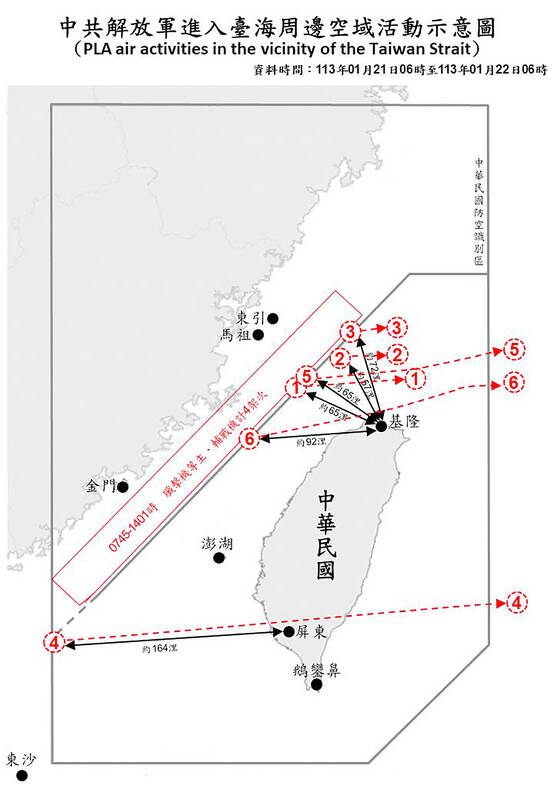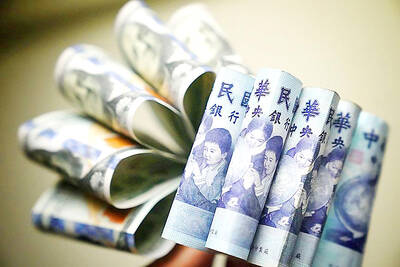The Ministry of National Defense yesterday said that six Chinese balloons either flew over the nation or through airspace just north of it, while Chinese warplanes and navy ships were also detected in the area.
The dispatch of such balloons, which generally disappear into the Pacific to the east, appears to be on the rise, although their purpose has not been publicly announced.
The ministry noted the balloon sightings on a list of Chinese People’s Liberation Army activity in the waters and airspace around Taiwan. One passed near the southern city of Pingtung, while the others flew just north of the Port of Keelung, an important naval base is located.

Photo courtesy of the Ministry of National Defense
It remains unclear whether the balloons have an explicit military function, but they appear to be part of a campaign of harassment against Taiwan.
In the lead-up to Jan. 13’s presidential and legislative elections, China had been stepping up such activities, along with its rhetorical threats, although Beijing’s threats have generally been seen as backfiring.
The Democratic Progressive Party won a third straight term in the presidency.
US President Joe Biden early last year vowed sharper rules to track, monitor and potentially shoot down unknown aerial objects after a three-week drama sparked by the discovery of a suspected Chinese spy balloon transiting much of the US.
Washington labeled the balloon a military craft and shot it down with a missile. It recovered what it said was sophisticated surveillance equipment.
China responded angrily, saying it was only a weather balloon that had blown off course and called its downing a major overreaction.
Those are sometimes referred to as China’s “gray area tactics” that cause consternation among its foes without sparking a direct confrontation. China has long blurred the lines between military and civilian functions, including in the South China Sea, where it operates a huge maritime militia — ostensibly civilian fishing boats that act under government orders to assert Beijing’s territorial claims.
China’s campaign of intimidation against Taiwan includes the regular deployment of Chinese warships and planes in waters and airspace around the nation, often crossing the middle line of the 160km-wide Taiwan Strait that divides them.
Between Sunday and early yesterday morning, four Chinese warplanes and four navy ships were detected around Taiwan, the defense ministry said.
Taiwan’s military monitored the situation with combat aircraft, navy vessels and land-based missile systems, it added.

A magnitude 6.4 earthquake struck off the coast of Hualien County in eastern Taiwan at 7pm yesterday, the Central Weather Administration (CWA) said. The epicenter of the temblor was at sea, about 69.9km south of Hualien County Hall, at a depth of 30.9km, it said. There were no immediate reports of damage resulting from the quake. The earthquake’s intensity, which gauges the actual effect of a temblor, was highest in Taitung County’s Changbin Township (長濱), where it measured 5 on Taiwan’s seven-tier intensity scale. The quake also measured an intensity of 4 in Hualien, Nantou, Chiayi, Yunlin, Changhua and Miaoli counties, as well as

STAY AWAY: An official said people should avoid disturbing snakes, as most do not actively attack humans, but would react defensively if threatened Taitung County authorities yesterday urged the public to stay vigilant and avoid disturbing snakes in the wild, following five reported snakebite cases in the county so far this year. Taitung County Fire Department secretary Lin Chien-cheng (林建誠) said two of the cases were in Donghe Township (東河) and involved the Taiwan habus, one person was bit by a Chinese pit viper near the South Link Railway and the remaining two were caused by unidentified snakes. He advised residents near fields to be cautious of snakes hiding in shady indoor areas, especially when entering or leaving their homes at night. In case of a

Credit departments of farmers’ and fishers’ associations blocked a total of more than NT$180 million (US$6.01 million) from being lost to scams last year, National Police Agency (NPA) data showed. The Agricultural Finance Agency (AFA) said last week that staff of farmers’ and fishers’ associations’ credit departments are required to implement fraud prevention measures when they serve clients at the counter. They would ask clients about personal financial management activities whenever they suspect there might be a fraud situation, and would immediately report the incident to local authorities, which would send police officers to the site to help, it said. NPA data showed

ENERGY RESILIENCE: Although Alaska is open for investments, Taiwan is sourcing its gas from the Middle East, and the sea routes carry risks, Ho Cheng-hui said US government officials’ high-profile reception of a Taiwanese representative at the Alaska Sustainable Energy Conference indicated the emergence of an Indo-Pacific energy resilience alliance, an academic said. Presidential Office Secretary-General Pan Men-an (潘孟安) attended the conference in Alaska on Thursday last week at the invitation of the US government. Pan visited oil and gas facilities with senior US officials, including US Secretary of the Interior Doug Burgum, US Secretary of Energy Chris Wright, Alaska Governor Mike Dunleavy and US Senator Daniel Sullivan. Pan attending the conference on behalf of President William Lai (賴清德) shows a significant elevation in diplomatic representation,